If you’re planning a trip to Seward, Alaska, there’s no better way to take in its natural beauty than on a trail. Whether you’re looking for an easy stroll along Resurrection Bay or are up to an all-day trek in Kenai Fjords National Park, we’ve compiled the 9 best hikes in Seward, Alaska. Stay tuned to the end of the article for tips on the best time of year to visit, what to pack, and more!
🐻 Practice Bear Safety! Reading about and practicing bear safety when hiking in Seward, Alaska is of upmost importance to ensure your safety while hiking. More information on the NPS’s Bear Safety Page.
Note: We use affiliate links which provide us a little kickback each time you use one of our links and make a purchase, without any additional cost to you. We do not recommend products that we don’t already love or have heard great things about, so you can trust we’re only suggesting great products to you.
1. Harding Icefield Trail
The Harding Icefield Trail in Kenai Fjords National Park was our absolute favorite hike we’ve ever done to date! Stretching 8.6 miles (13.8 km), this is the longest and hardest hike in Seward, Alaska, but really worth it if you have the time and ability.
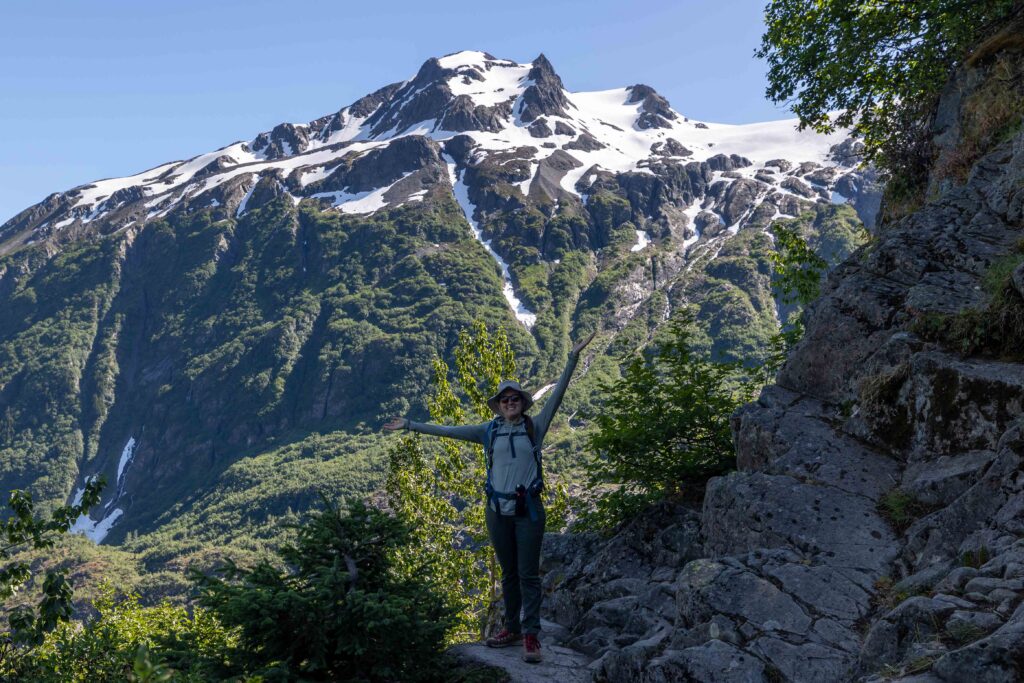
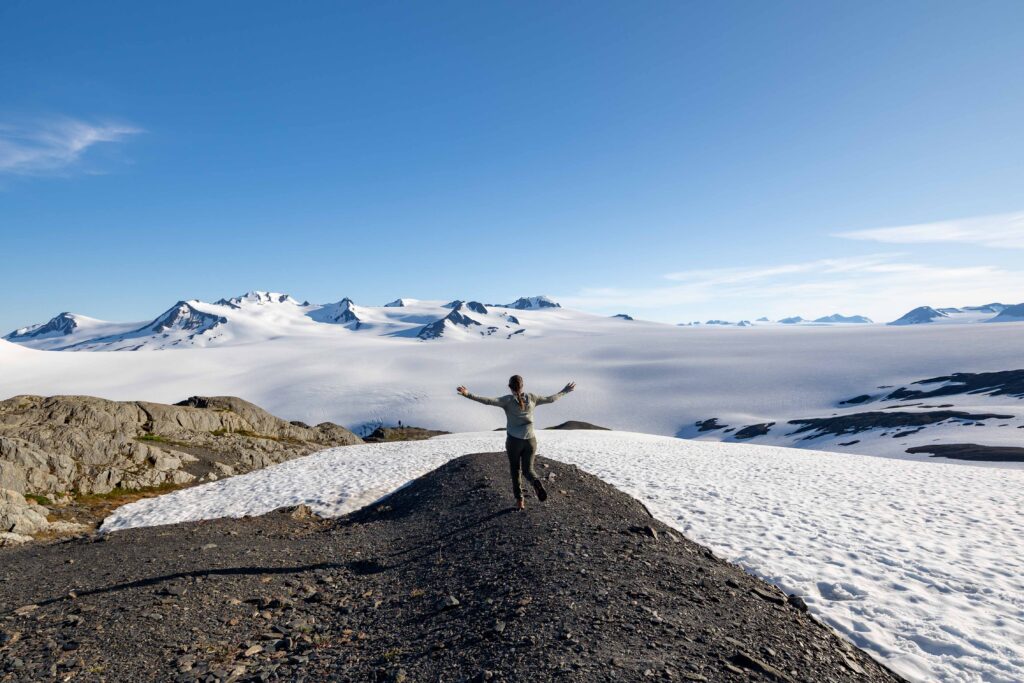
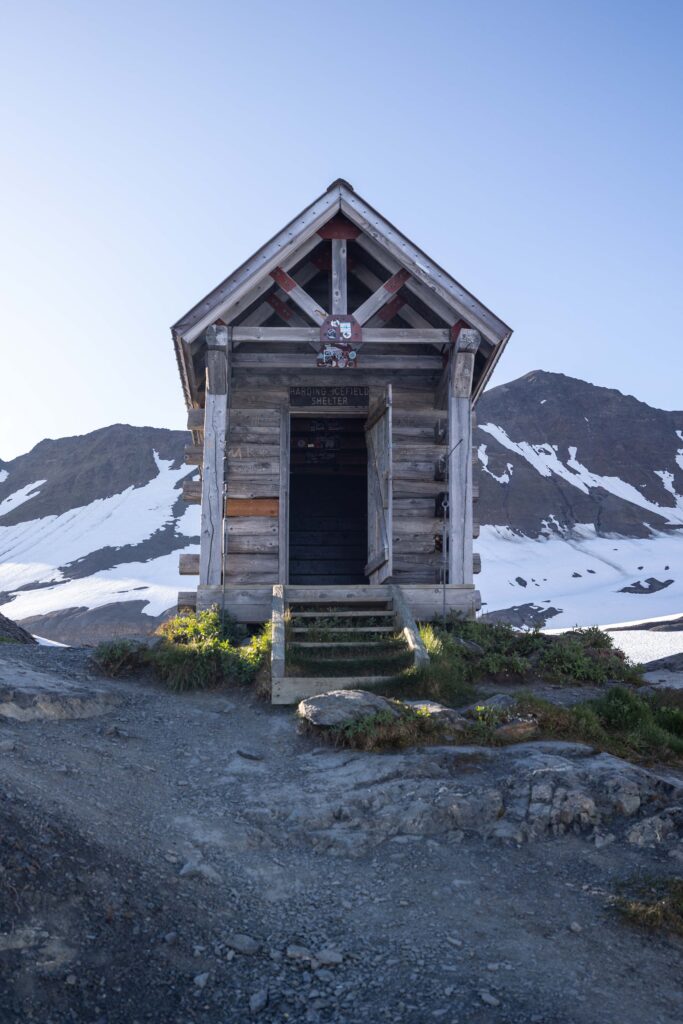
The top of the hike rewards you with views of a vast icefield with mountains peaking out from it. This view was incredibly humbling to see. The views are incredible throughout the entirety of this 6 to 7-hour hike as well—we regularly stopped to take photos!
If you keep an eye out, you might be able to enjoy some wildlife spotting, like mountain goats or marmots enjoying the high alpine meadows near the cliffs as well.
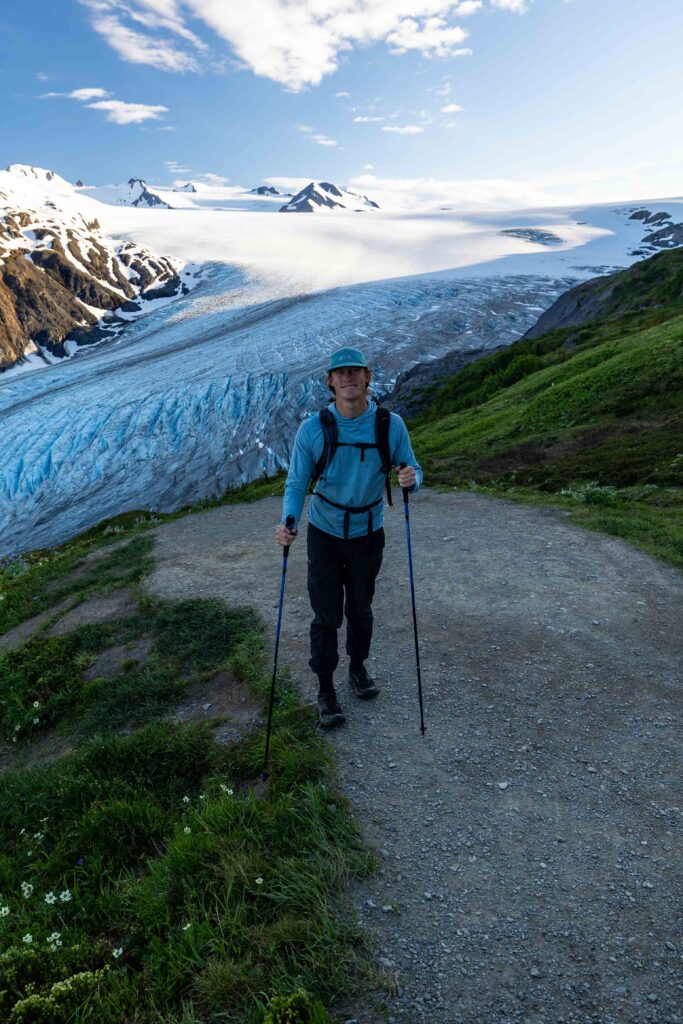
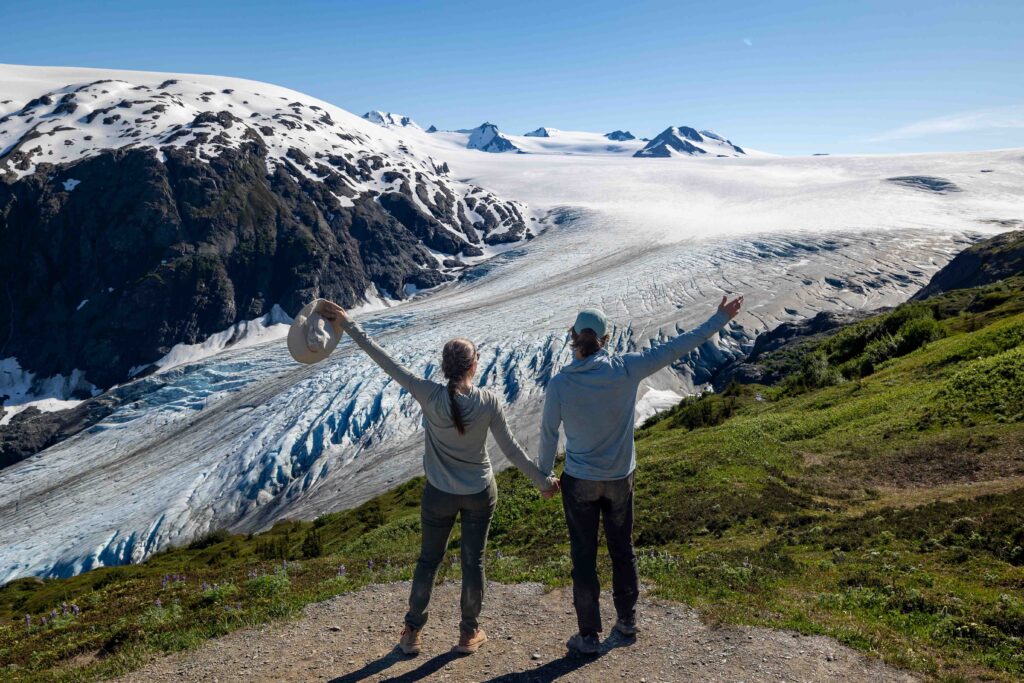
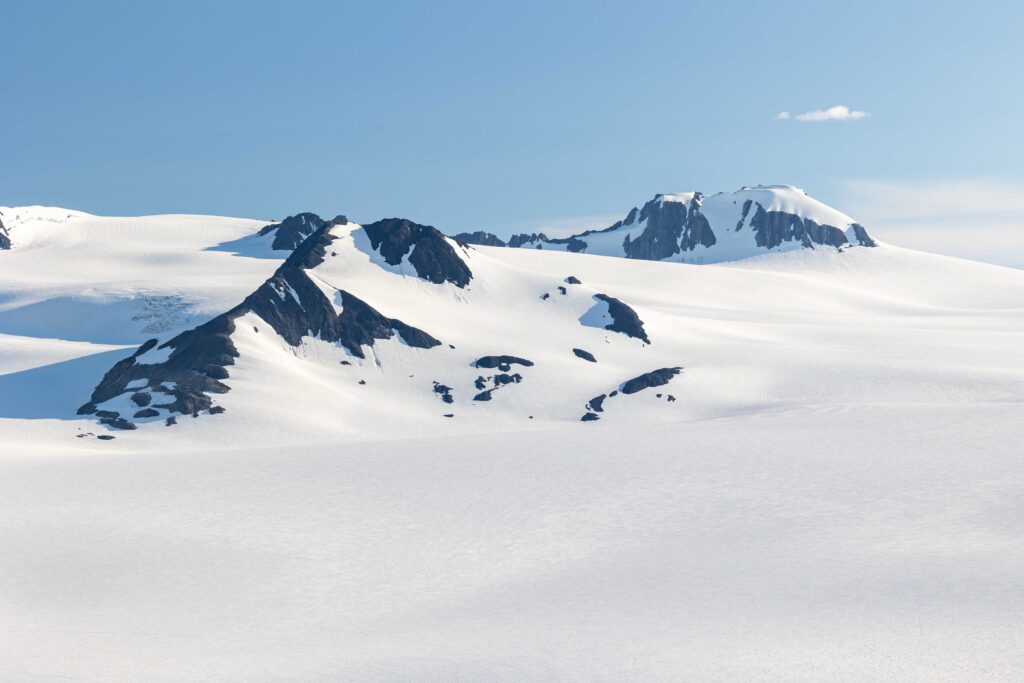
Be prepared for a serious workout with this trail as it climbs 3,235 feet (986 m) in elevation. We completed this trail after doing the Exit Glacier Overlook trail, and we recommend you start early since it is such a long and challenging hike! Our hiking poles really came in handy on this trail, especially on the snowy parts of the trail.
Distance: 8.6 miles (13.8 km)
Difficulty: Hard
Elevation: 3,235 feet (986 m)
Estimated Time: 6-7 hours
2. Exit Glacier View Loop (Longer Version)
The Exit Glacier View Trail brings you to an overlook of Exit Glacier, a glacier derived from the Harding Icefield. This easy-to-moderate loop trail is also located within Kenai Fjords National Park and takes between 1 to 1.5 hours to hike.
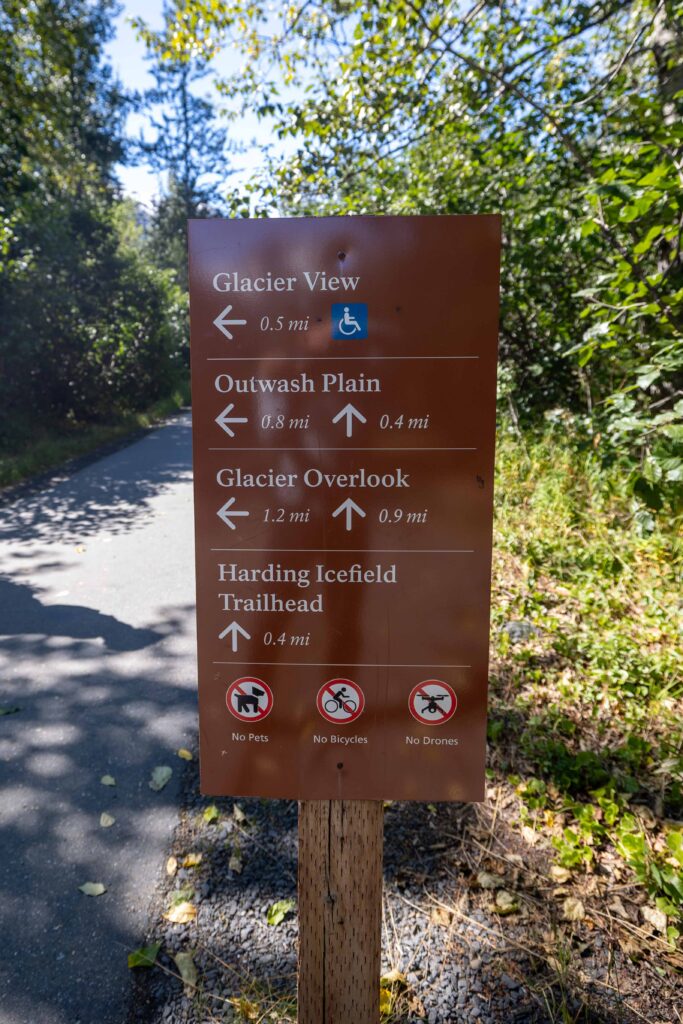
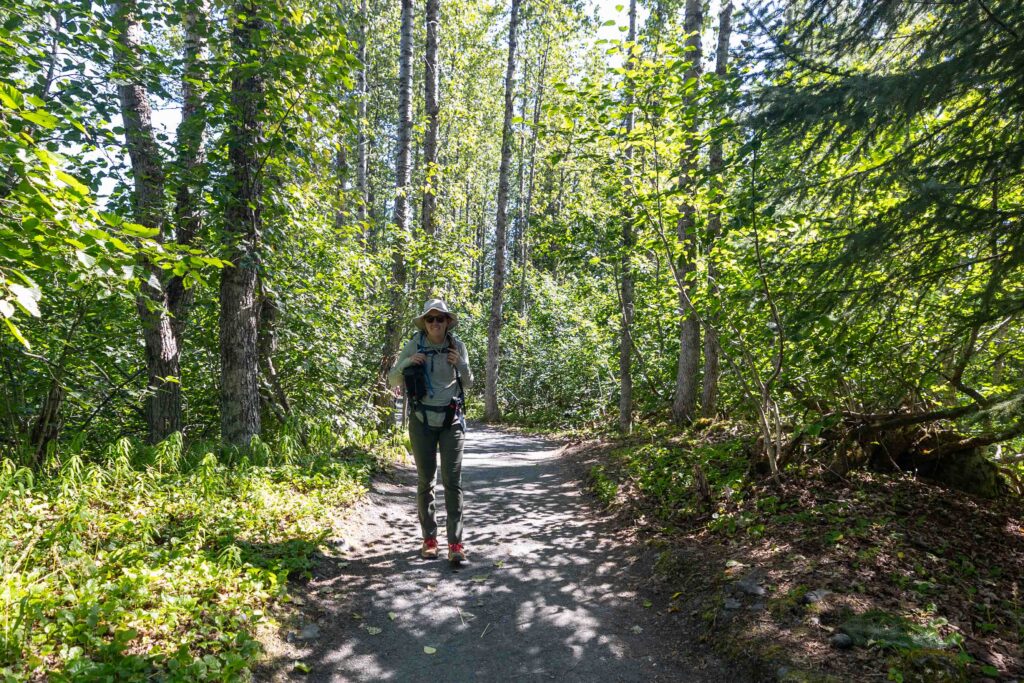
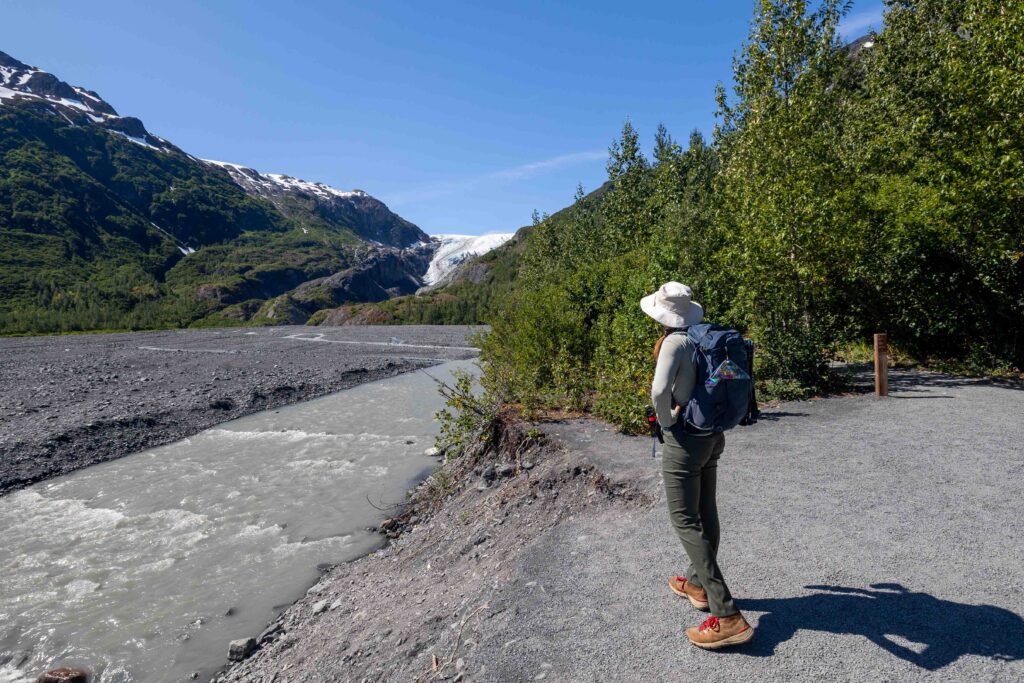
As you drive towards the trailhead, you’ll see small signs along the side of the road indicating the year that Exit Glacier passed through there. Then, once on the trail, you’re brought even closer to Exit Glacier, following its retreating path, a stark reminder of climate change. The final overlook, Exit Glacier Overlook, rewards you with spectacular views of this ever-moving glacier.
If you’re interested in going on a guided hike of this trail, park rangers lead Exit Glacier walks from late May through early September. These walks typically occur twice daily and last around 90 minutes. More information on NPS’s Ranger Programs Page.
🚧 Exit Glacier Road Closes in November! The road to Exit Glacier typically closes by mid-November upon the first major snowfall. This road becomes inaccessible to cars, but is still available to snowmobiles, snowshoeing, dogsleds, etc.
Distance: 2.2 miles (3.5 km)
Difficulty: Easy-Moderate
Elevation: 314 feet (96 m)
Estimated Time: 1 – 1.5 hours
3. Exit Glacier View Loop (Shorter Version)
If you prefer a shorter version of the Exit Glacier View Loop, you can hike the first 1.1 miles (1.8 km), following this map. This shorter version can be finished in as little as 30 minutes. Although you won’t get as close to the glacier as the full version, you’ll still get close enough to see it in the distance.
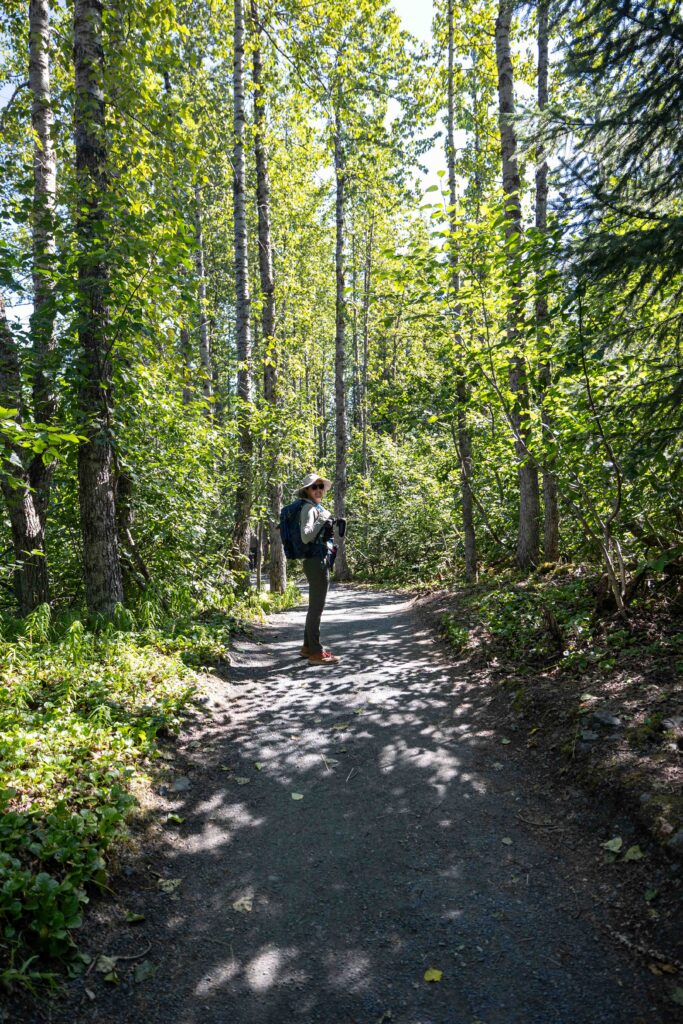
Distance: 1.1 miles (1.8 km)
Difficulty: Easy
Elevation: 85 feet (26 m)
Estimated Time: 30 minutes – 1 hour
4. Mount Marathon
If you’re up for a challenge, consider hiking the steep slope up to Mount Marathon. Every July 4th since 1915, racers from all over the world have come to participate in a famous footrace up to the boulder at Race Point and back, turning into one of Alaska’s oldest traditions.
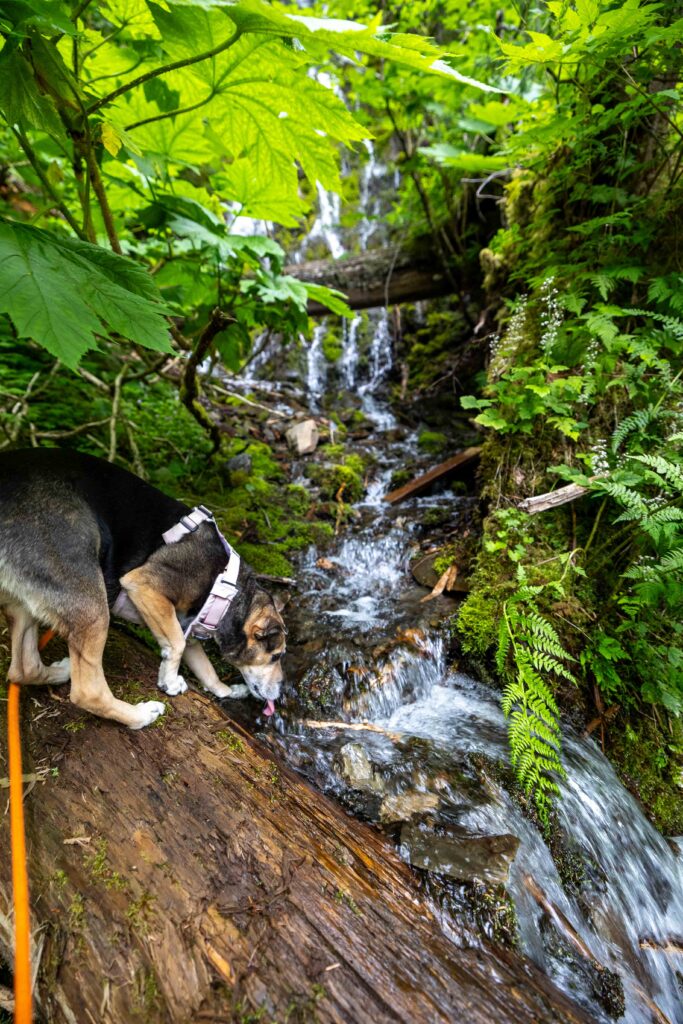
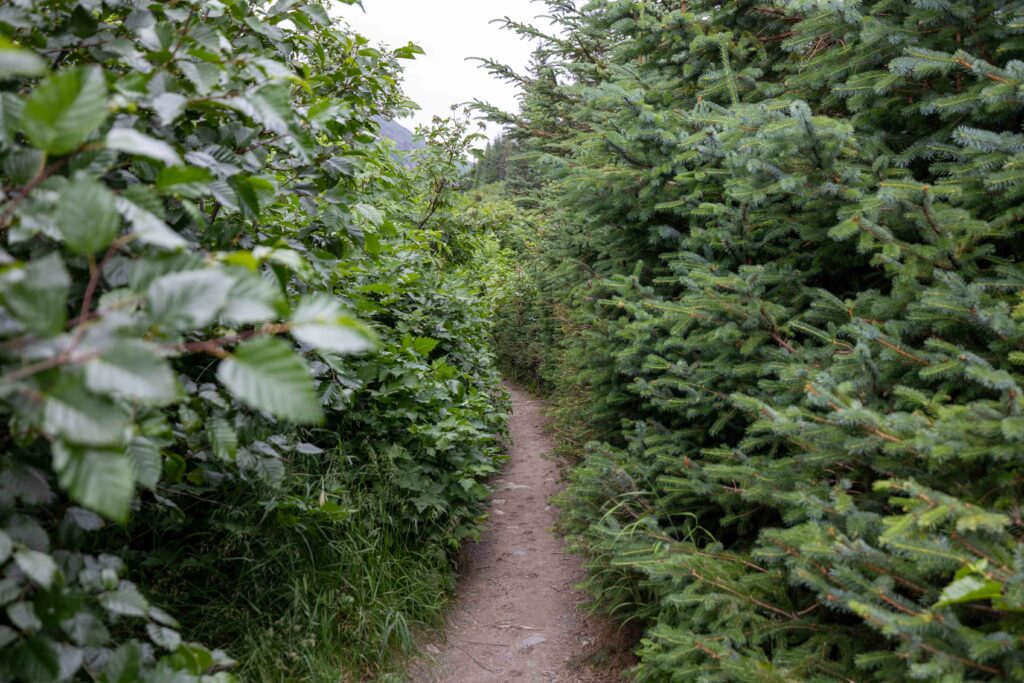
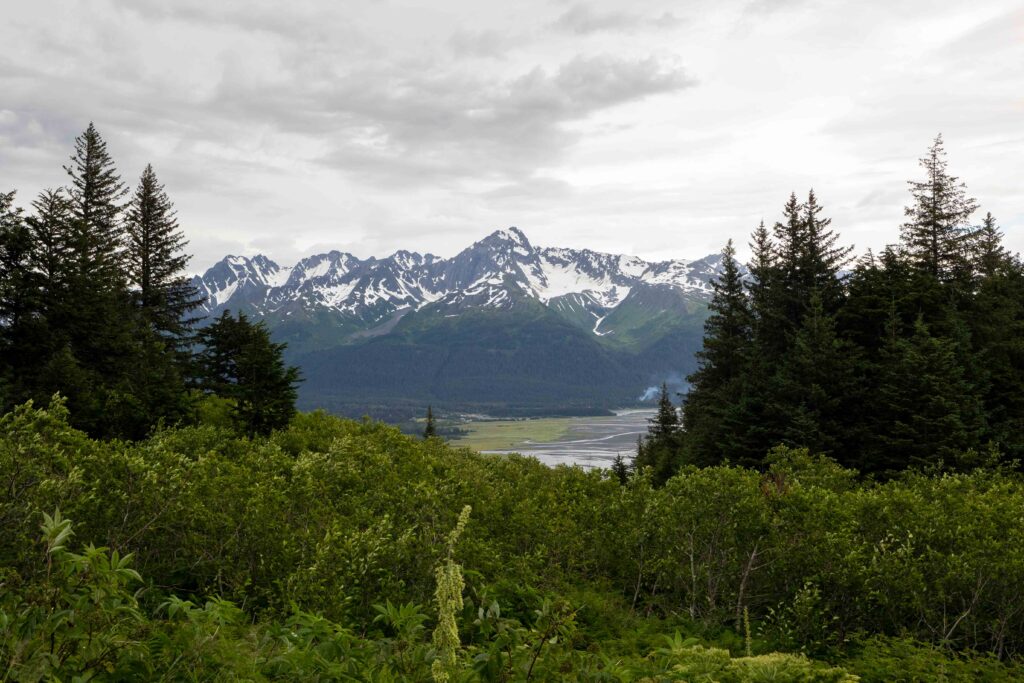
This race is known to be extremely challenging for its elevation gain, and the fact that hikers are climbing up scree (loose rock). That being said, feel free to hike at your own pace, like Elliot and Ollie did, taking breaks when needed and enjoying the views overlooking Resurrection Bay.
🗺️ Out-and-Back Option: If you’re following the AllTrails map below, know that you can hike Mount Marathon as an out-and-back trail, turning around at Race Point, instead of completing the entire 4.2-mile (6.8-km) loop as the map shows.
Distance: 4.2 miles (6.8 km)
Difficulty: Hard
Elevation: 2,923 feet (891 meters)
Estimated Time: 4.5-5 hours
5. Caines Head Trail
Caines Head Trail is an all-day trek that brings you all the way to the abandoned Fort McGilvray. This huge concrete fort was built on top of a 650-foot cliff to defend Seward during World War 2.
This 7-to-8-hour trail is a continuation of the Tonsina Creek Trail, which also starts from the parking lot at Lowell Point. There is a $5 fee to park, and the lot is quite small, so we don’t recommend parking here if you have a larger vehicle.
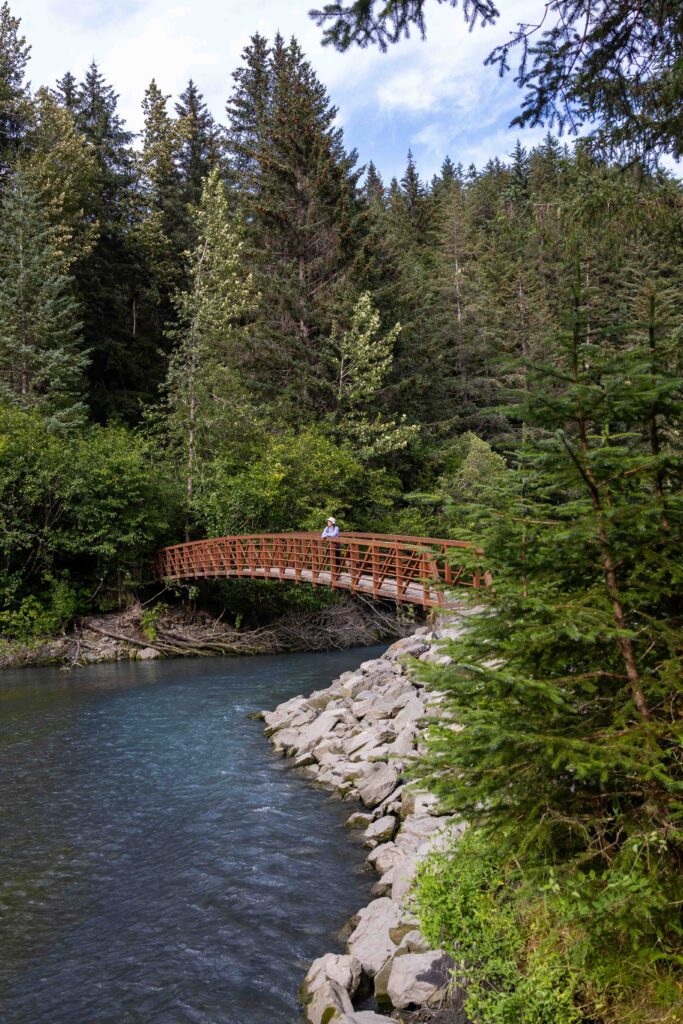
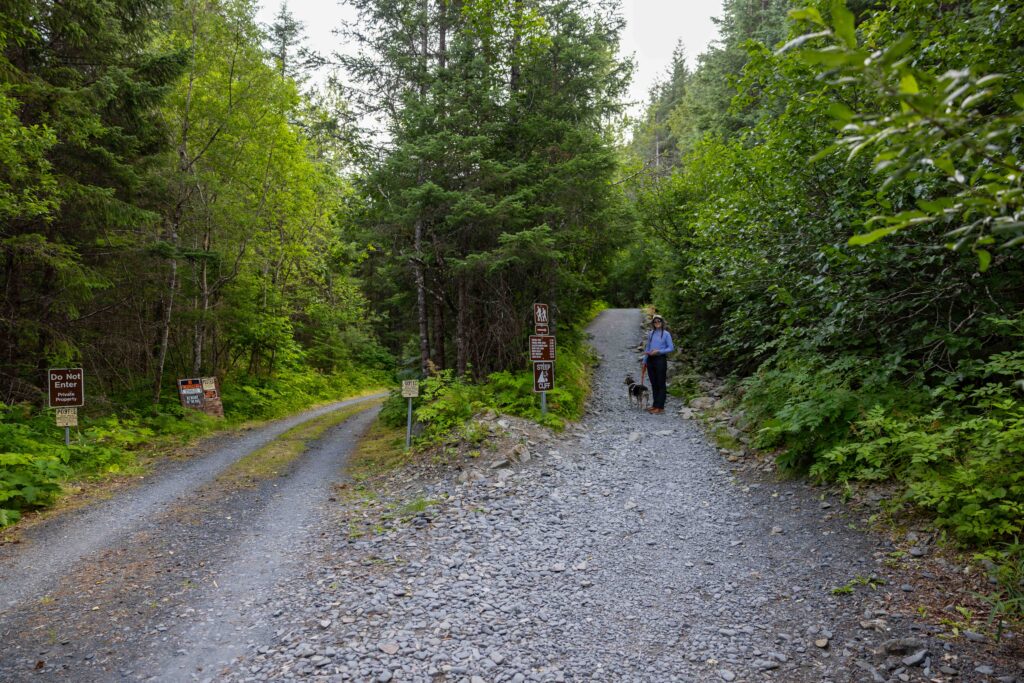
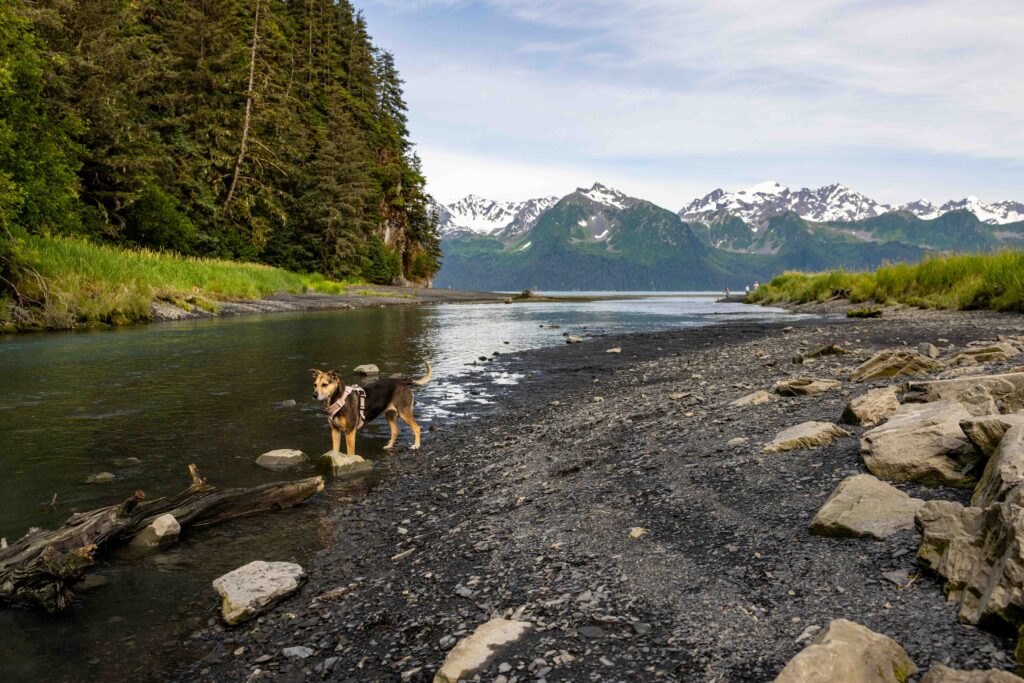
Keep in mind that the Coastal Trail section of this hike is only passable during very low tides. Because of this, you’ll need to check the tide charts and plan your journey carefully, or consider arranging a water taxi from Miller’s Landing to access.
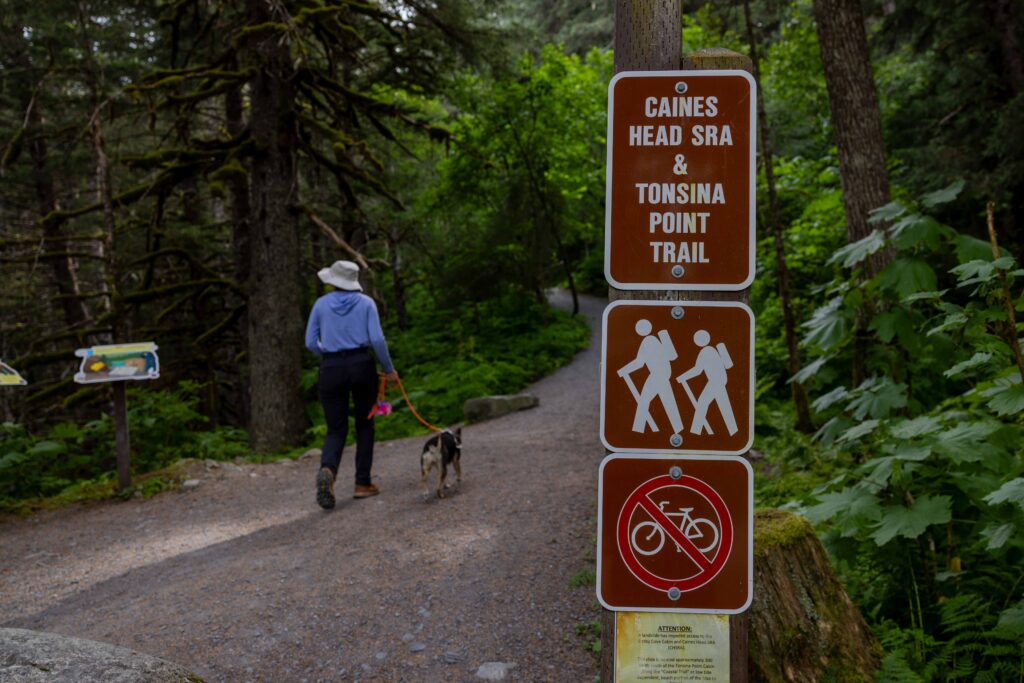
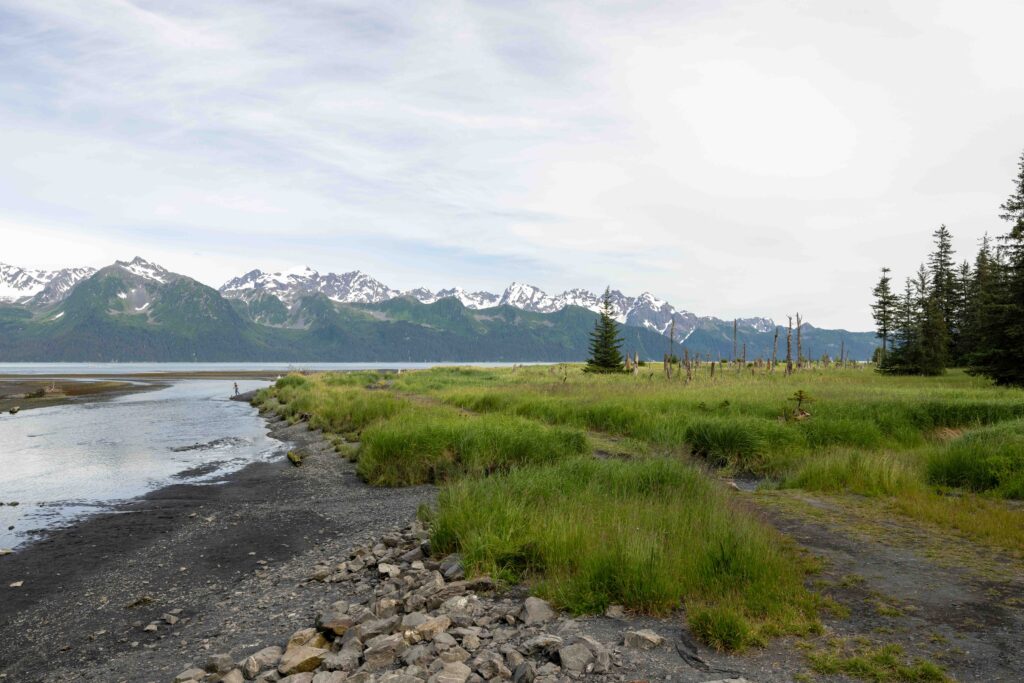
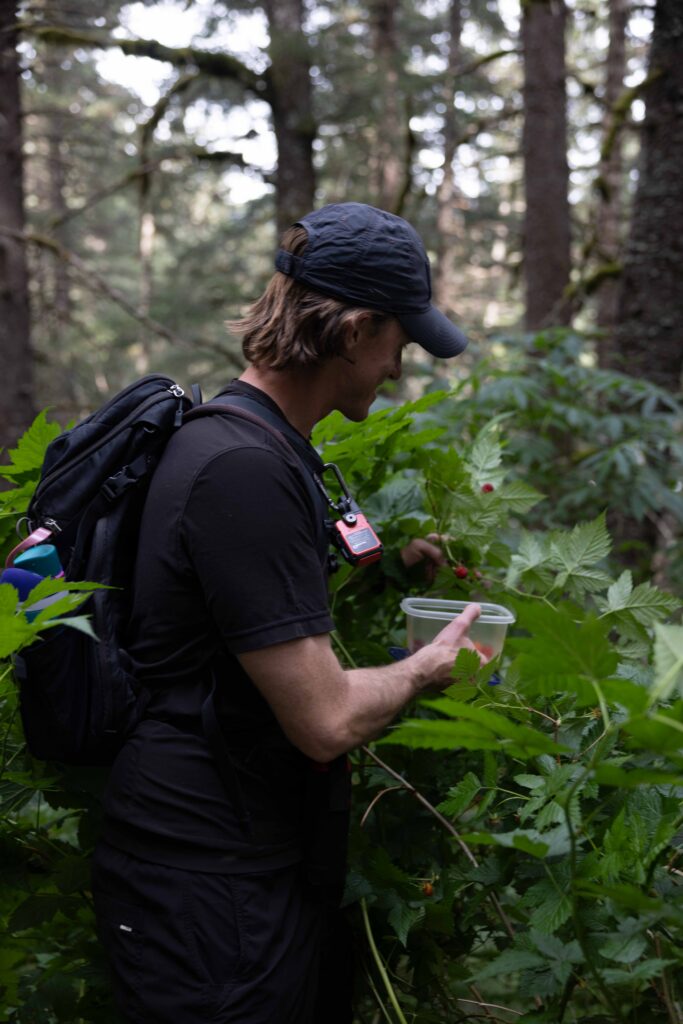
You can always ask Kenai Fjord park rangers or workers at Miller’s Landing for a next-day recommendation on when to leave and come back to avoid high tide. Typically, they’ll recommend that you set out in the early morning to avoid having to wait for the tide to recede. During the long Alaska summers, you typically don’t have to worry about running out of sunlight since daylight is in high supply.
Distance: 14.4 miles (23.2 km)
Difficulty: Hard
Elevation: 2,749 feet (838 m)
Estimated Time: 7-8 hours
6. Tonsina Creek Trail
Tonsina Creek Trail is a 3-mile (4.8-km) moderate trail stretching from Caines Head Trailhead to Tonsina Creek. This trail is relatively flat and will take you anywhere between 1.5 to 2 hours to complete. Parking at the Lowell Point trailhead is $5, and the lot is relatively small, so we don’t recommend it if you’re traveling in a large vehicle.
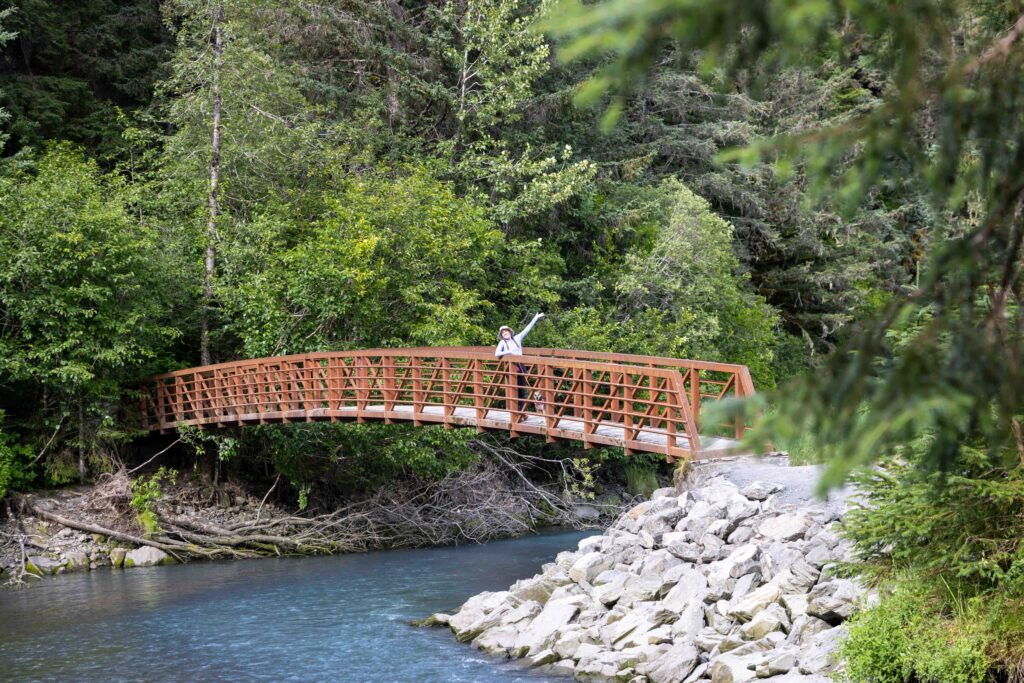
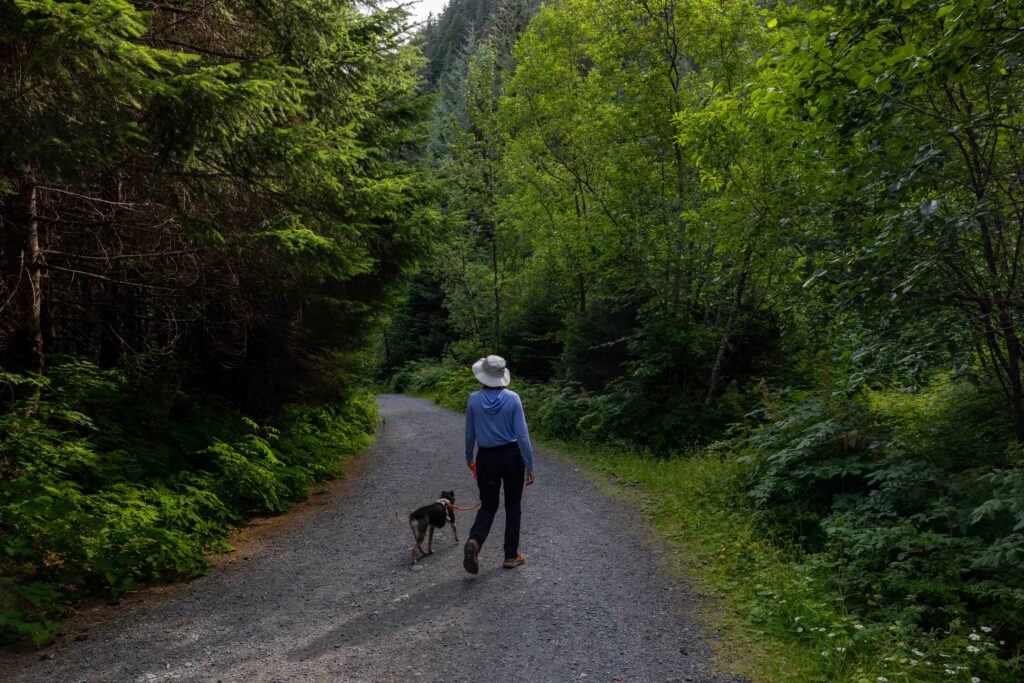
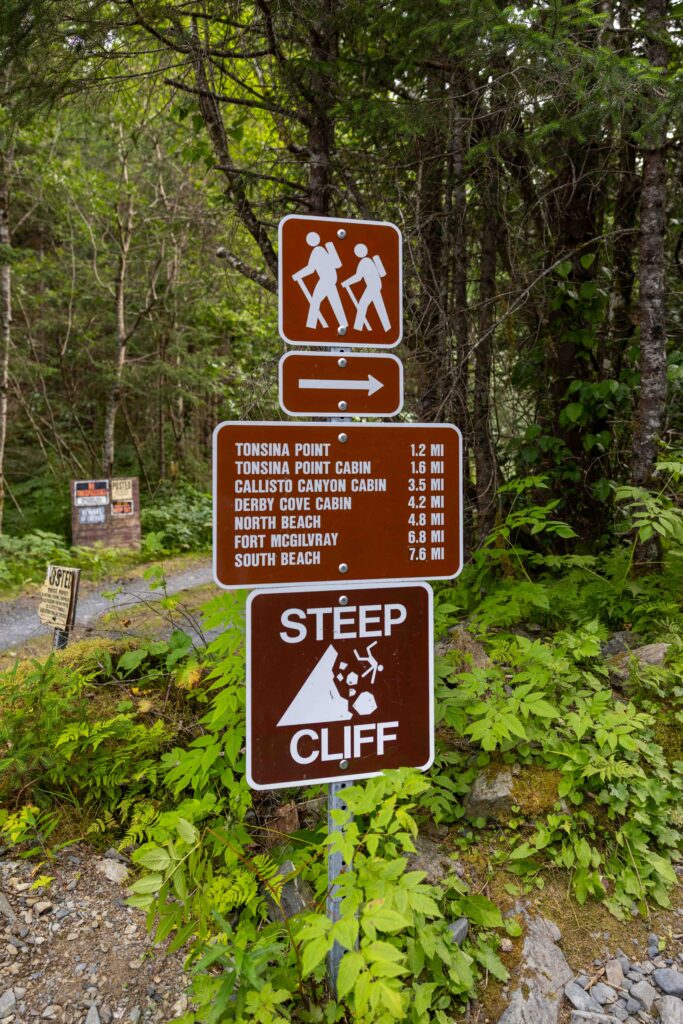
Along the trail, there were tons of salmon berries that we picked as we walked. Although the trail ends at Tonsina Creek, you have the option to continue your hike all the way to Caines Head, adding another 11.4 miles (18.4 km) round-trip to your hike. If you decide to continue, you must time your hike based on the tide schedule since some of the trail is inaccessible during high tide.
Distance: 3 miles (4.8 km)
Difficulty: Moderate
Elevation: 652 feet (199 m)
Estimated Time: 1.5-2 hours
7. Two Lakes Trail
Two Lakes Trail is located right in town near the base of Mount Marathon in Two Lakes Park, offering a quick escape into the Alaskan rainforest. This easy, family-friendly loop trail is less than a mile long and winds you around two beautiful lakes.
If you’re in Seward for more than a few days, it’s a great casual morning or picnic plan that will take you away from the busier harbor area. That being said, if we were in Seward for just a day or two, we wouldn’t put this trail at the top of our lists.
Distance: 0.8 miles (1.4 km)
Difficulty: Easy
Elevation: 138 feet (42 m)
Estimated Time: 30 minutes – 1 hour
8. Sea Otter Trail (Waterfront Shore Path)
The Sea Otter Trail (also known as the Waterfront Shore Path) is an easy, family-friendly 1.9-mile (3.1-km) walk in downtown Seward that’s a great alternative to some of the longer trails in Seward. There’s plenty of parking available and you have a good chance to see sea lions, sea otters, seals, and, if you’re lucky, the occasional whale!
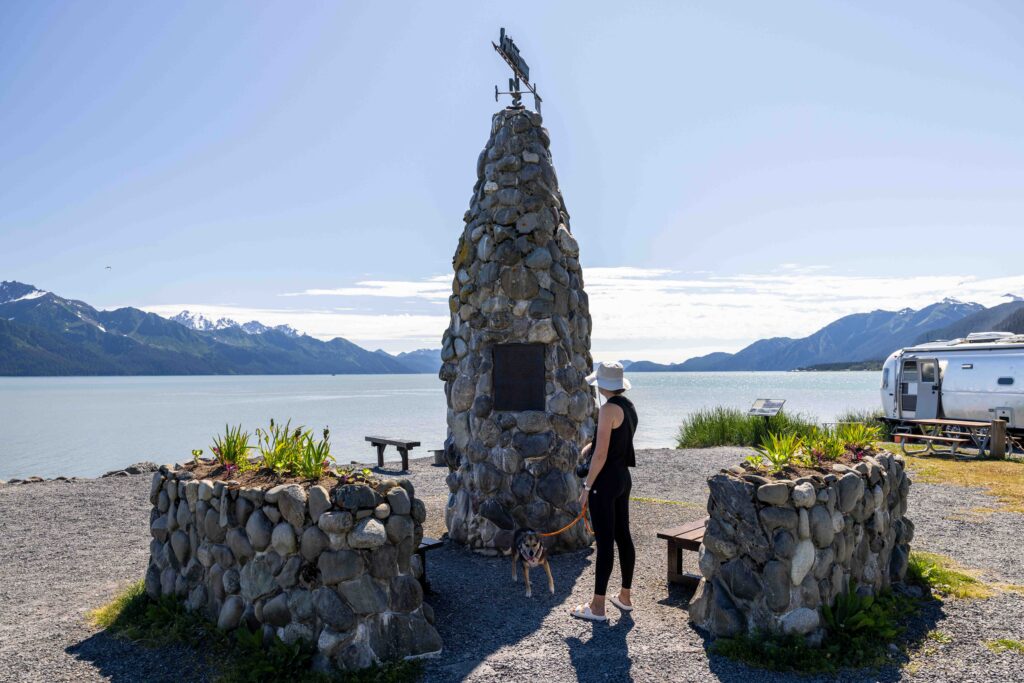
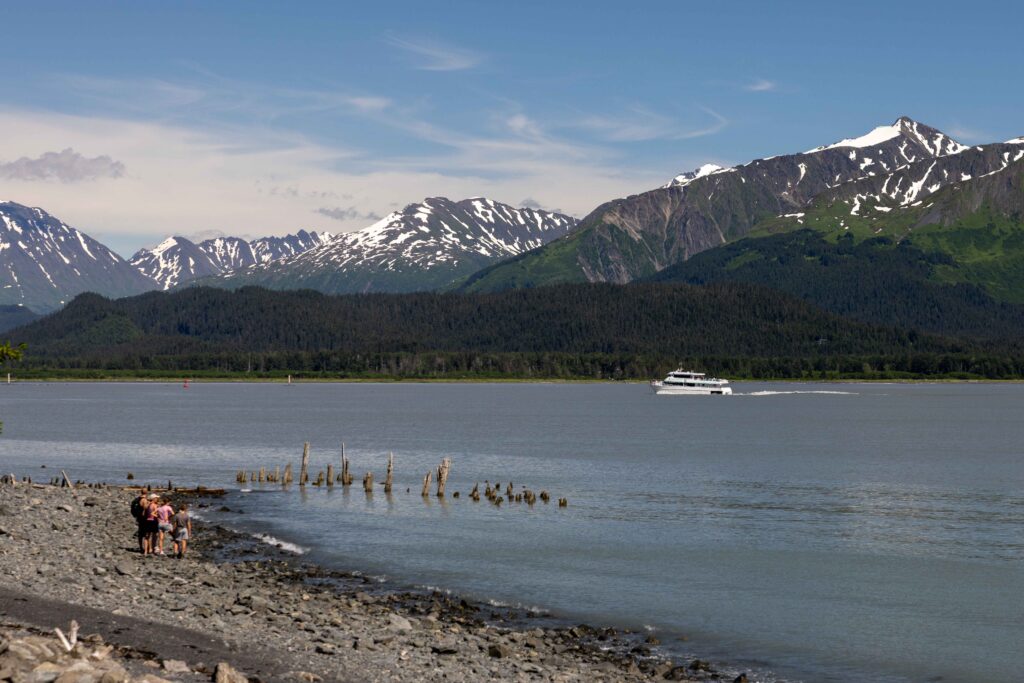
If you’re interested in going on a guided walk, park rangers lead weekly Junior Ranger Walks along the Seward waterfront from June to August. These walks typically last 90 minutes and, although designed for ages 8 to 12 to earn their Junior Ranger Badge, can be enjoyed by anyone. More information on NPS’s Ranger Programs Page.
Distance: 1.9 miles (3.1 km)
Difficulty: Easy
Elevation: 32 feet (10 m)
Estimated Time: 30 minutes – 1 hour
9. Lost Lake Trail
The Lost Lake Trail leads you into the nearby Chugach National Forest and up to a gorgeous valley with Box Canyon running through it. You’ll pass by views of glaciers as well as soaring mountains. Although we didn’t attempt this challenging trail, it’s highly rated for its stunning views, well-maintained path, and gorgeous views of Lost Lake as a reward before turning back.
🌄 Start Early! Hikers recommend starting this trail early as it takes a total of 7-7.5 hours on average to complete.
Distance: 13.7 miles (22 km)
Difficulty: Hard
Elevation: 2,585 feet (788 m)
Estimated Time: 7-7.5 hours
🗺️ Map of the 9 Best Hikes in Seward, Alaska
How to use this map: We have saved the locations from this guide on this map. You can save this map to your Google Maps by pressing the star icon. In your Google Maps, click the menu icon and then Saved Maps, where this map will appear.
🥾Hiking Essentials in Seward, Alaska
Below, we’ve outlined all the hiking gear we recommend for hitting the trails in Seward, Alaska. In this first section, we’ve highlighted specific pieces that you might need to purchase or rent if it’s your first time visiting the area.
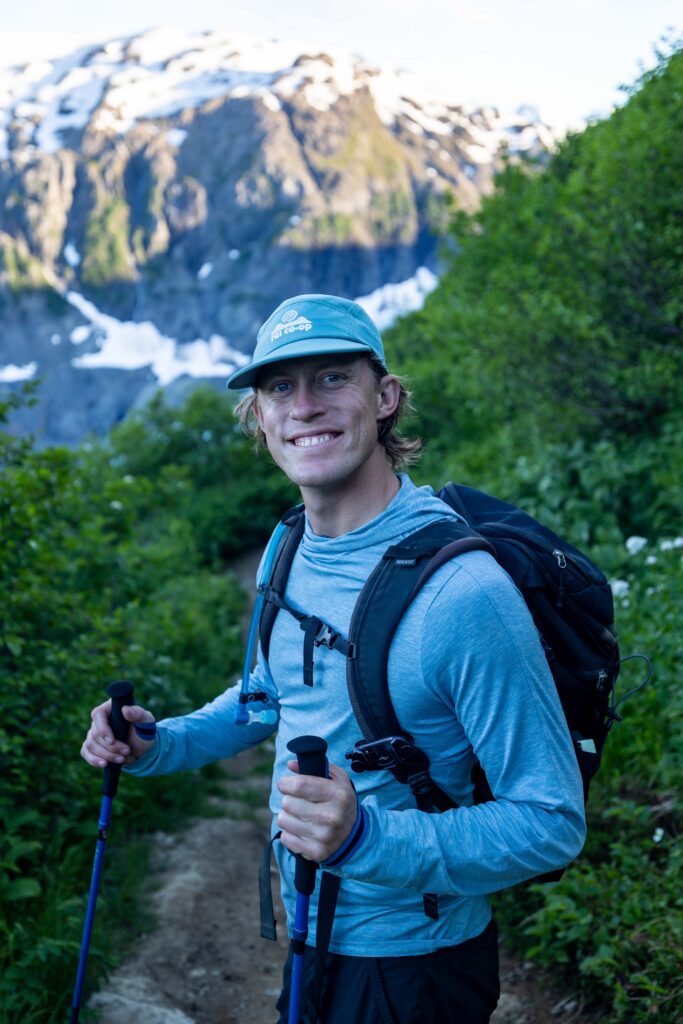
Alaskan Hiking Essentials
- Bear Spray – Park officials recommend hiking with bear spray for emergency use, as well as becoming familiar with bear safety practices. You can find bear spray for rent or to purchase in downtown Seward.
- Microspikes – Microspikes can be attached to the bottom of your hiking shoes to improve traction when hiking over snow and/or ice. If you’re planning to hike in areas with ice and snow in the summer or at any point in the winter, microspikes will become your best friend.
- Hiking poles – Especially on long, high-elevation hikes like the Harding Icefield Trail, a solid pair of hiking poles really helps take the pressure off of joints.
🐻 Rent Bear Spray! If you want to save some money, you can rent bear spray in Anchorage at a spot like Alaska Bear Spray Rental instead of buying a whole canister. Also, if you plan on flying at any point, you’ll have to dispose of your bear spray anyway.
Hiking Essentials
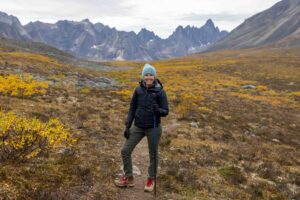
Read next: Hiking Gear for Beginners!
Sun Protection
Safety Essentials
📅 When to Visit Seward, Alaska
The most popular time to visit Seward is during the summer season (June through August), as this is when the weather is mildest and access to Kenai Fjords National Park is open. For many visitors, timing their trip comes down to weighing crowds against access:
- Summer (June–Aug): Peak season with the warmest weather and full road access to Exit Glacier.
- Shoulder Seasons (May & Sept): Fewer crowds and mild weather, but some services may be reduced.
- Winter (Oct–Apr): Low crowds but very cold temperatures, highly reduced services, and extremely limited park access.
✈️ How to Get to Seward, Alaska
Tucked away at the head of Resurrection Bay, Seward is one of the most accessible—and scenic—coastal towns in Alaska, reachable by car, train, bus, or even air taxi. Whether you’re coming from near or far, here’s a breakdown of your options:
- Car—The Seward Highway is kept clear year-round, connecting Anchorage to Seward in just over 2 hours. If you’re interested in driving but don’t have your own vehicle, consider renting a car for the journey.
- Plane—Seward Airport is a private airport located just next to downtown Seward, servicing private air taxis for quick journeys. There are no major commercial flight services that travel to Seward at the moment.
- Public Transport—Choose between the 4-hour Coastal Classic Train connecting Anchorage to Seward, or a faster, more budget-friendly bus service. If you arrive in Seward without a car, you can catch the Exit Glacier Shuttle from downtown to Exit Glacier Nature Center, leaving you right at the trailheads.
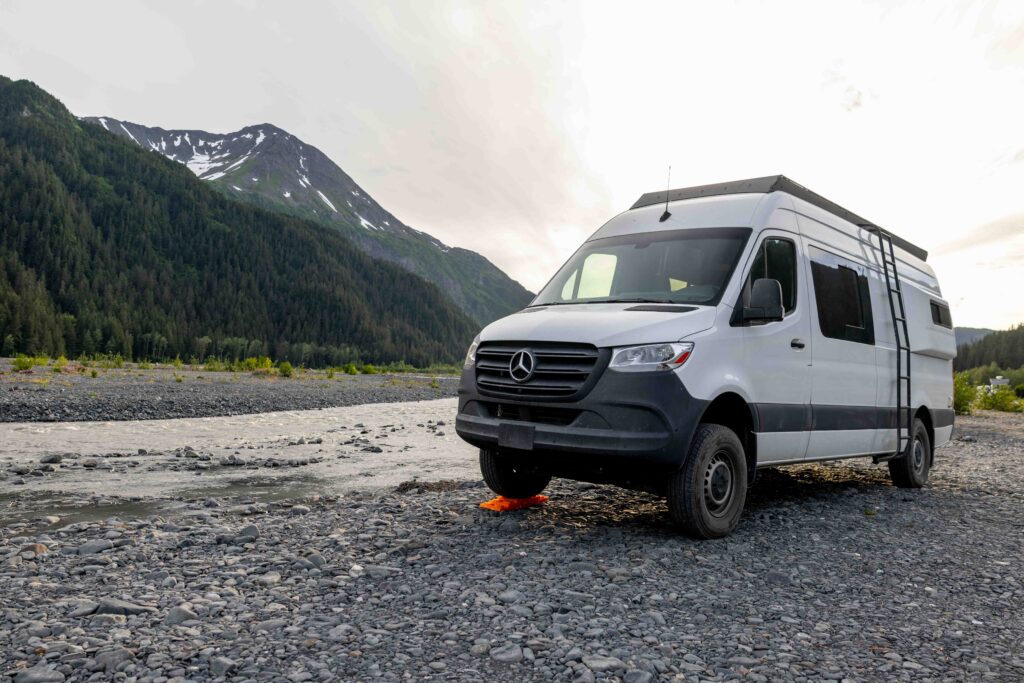
🏨 Where to Stay in Seward, Alaska
Whether you’re looking to camp under the stars or cozy up in a log cabin, Seward, Alaska, has a variety of accommodations. If visiting during Seward’s peak season (June, July, and August), be sure to reserve several months in advance if you have your eye on a specific accommodation.
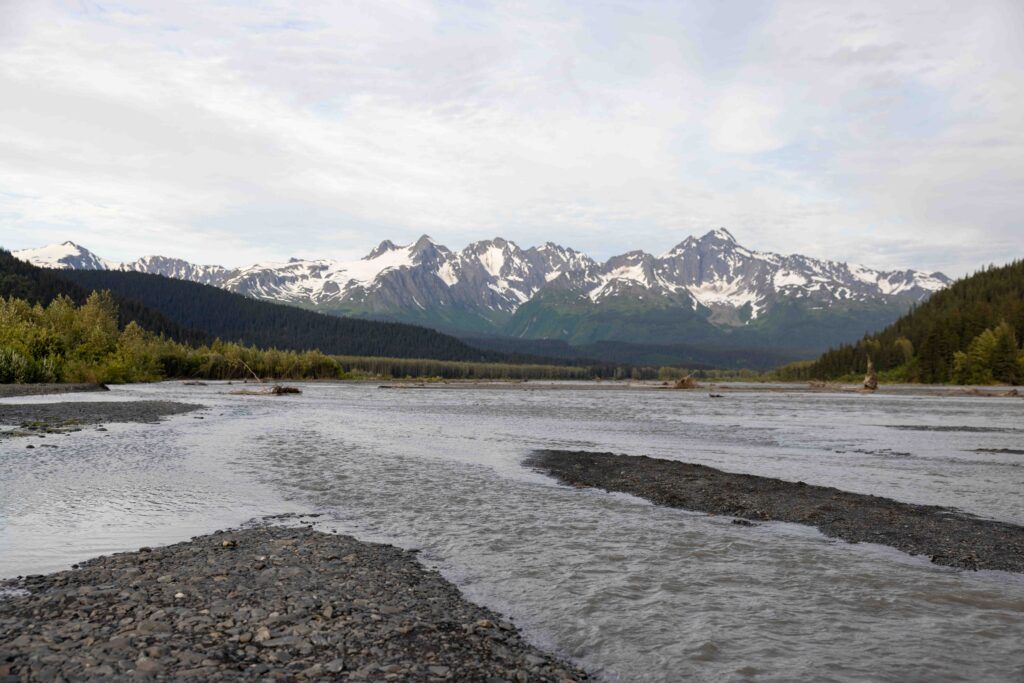
Here’s a breakdown of all the stay options Seward has to offer:
- Hotels & Inns— Stay in a spacious guest house like Seward’s Guest Home, a cozy downtown inn like Sea Treasures Inn, or a cozy cabin like A Cabin on the Cliff.
- Camping—Camp in Kenai Fjords at their free first-come, first-serve Exit Glacier campground, go backcountry camping (allowed throughout the park), or reserve a public-use cabin here for $75 per night. Check out nearby campgrounds and RV Parks like Howling Wolf Resort, Nash Bayfront Campground, and RipTide RV Resort. More camping options in our camping guide.
- BLM Camping—You can also check for BLM Land via iOverlander, which we always refer to when looking for public land to stay on for free. We stayed at this free camping spot on the Exit Glacier river bed with about 50 other rigs while we visited Seward.

Try Harvests Hosts and receive a free month on us!
Members get unlimited overnight stays at thousands of small businesses, including farms, wineries, breweries & distilleries, and attractions, that invite RVers to park for safe and convenient stays.
Use code schoandjo20 at checkout for an extra discount!
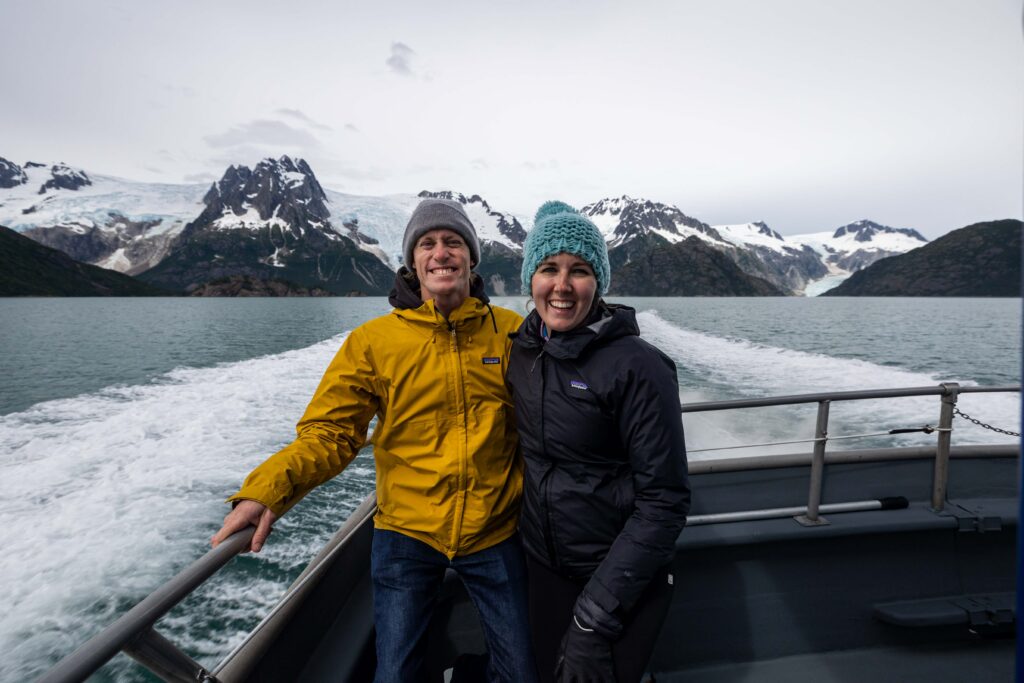
Read Next:
21 Best Things to Do in Seward, Alaska
📰 Related Articles
- 21 Best Things to Do in Seward, Alaska
- Our 5 Favorite Spots to Eat in Seward, Alaska
- Guide to Campgrounds and RV Parks in Seward, Alaska
- 9 Best Things to Do in Kenai Fjords National Park
- How to Choose the Best Kenai Fjords Boat Tour
- How to Visit Kenai Fjords National Park in 1, 2, or 3 Days
📺 Watch on YouTube
🔍 Ready to Visit Seward, Alaska?
Pin this guide to the best hikes in Seward, Alaska to make planning your upcoming trip a breeze!
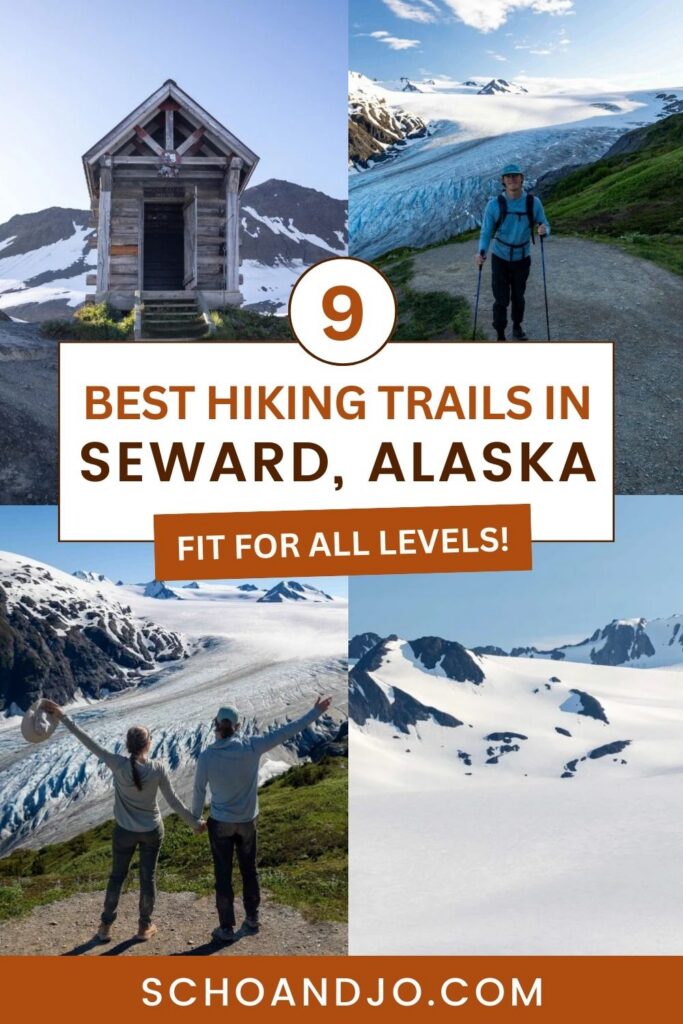
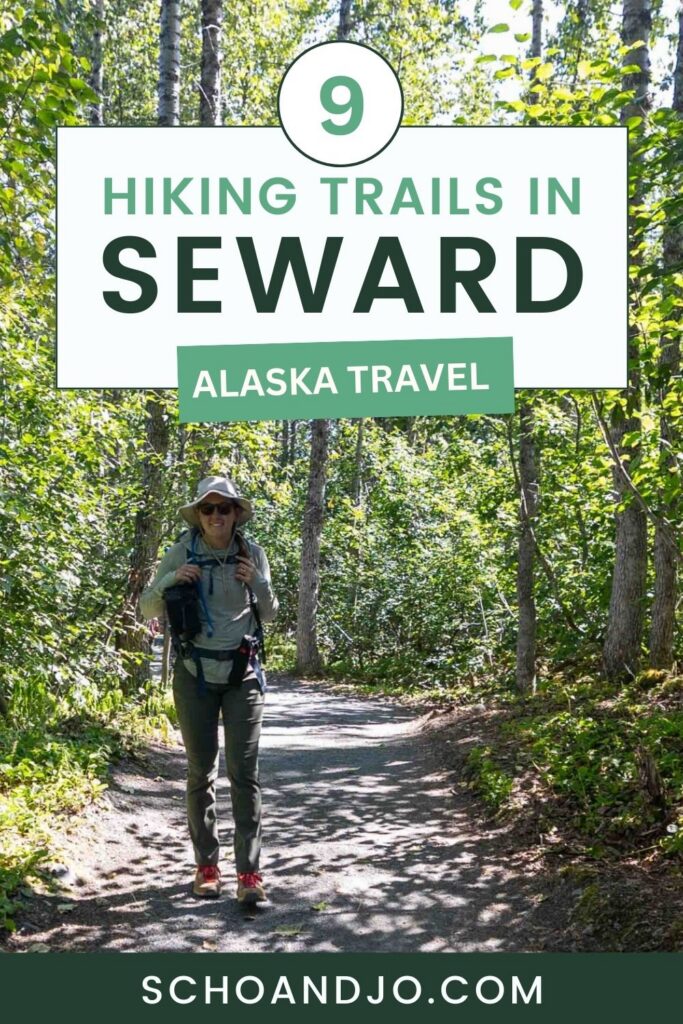
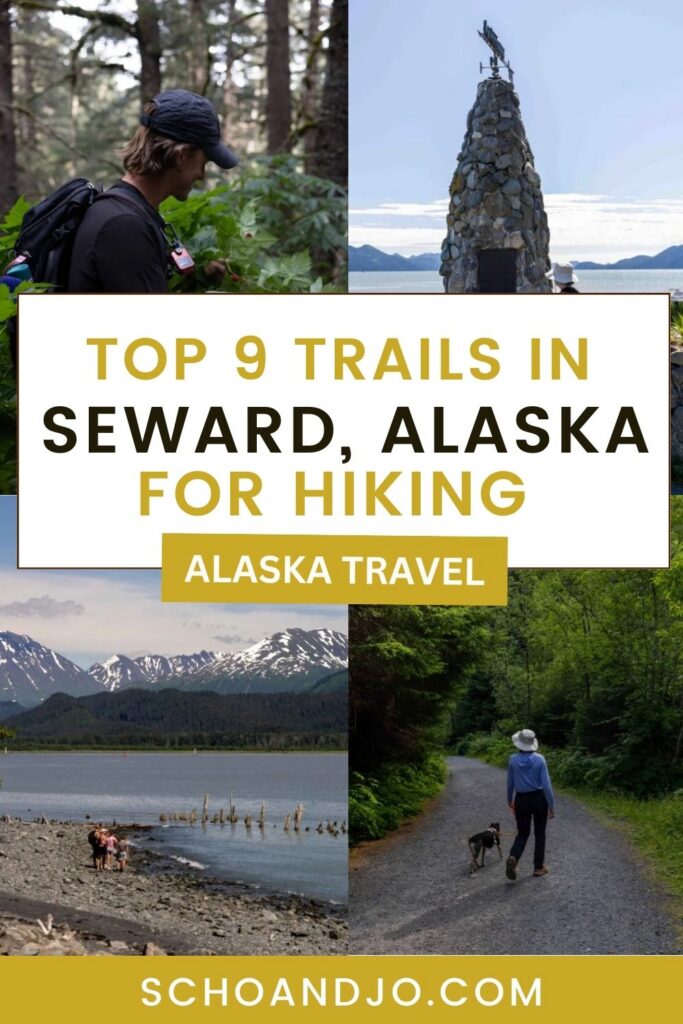

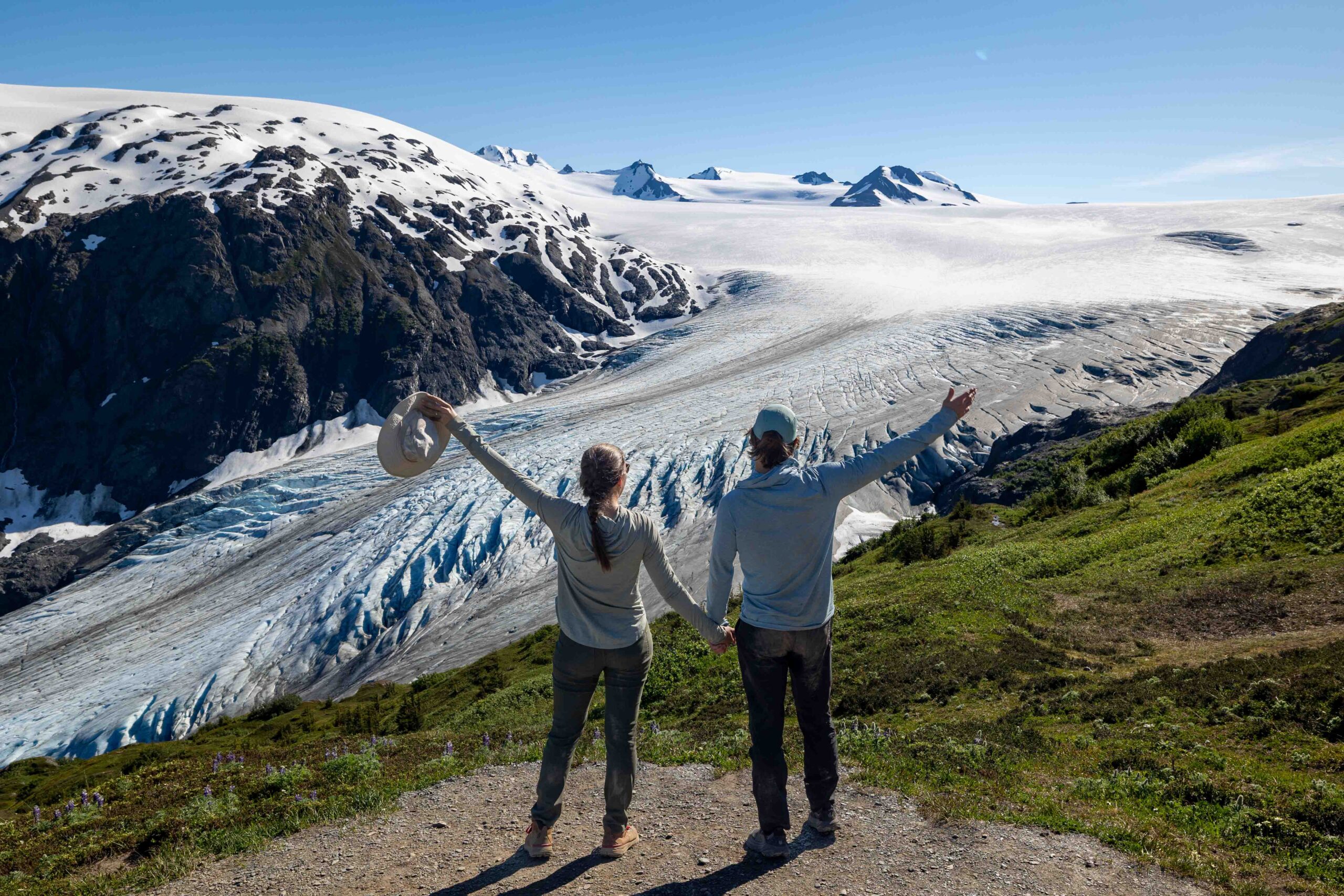
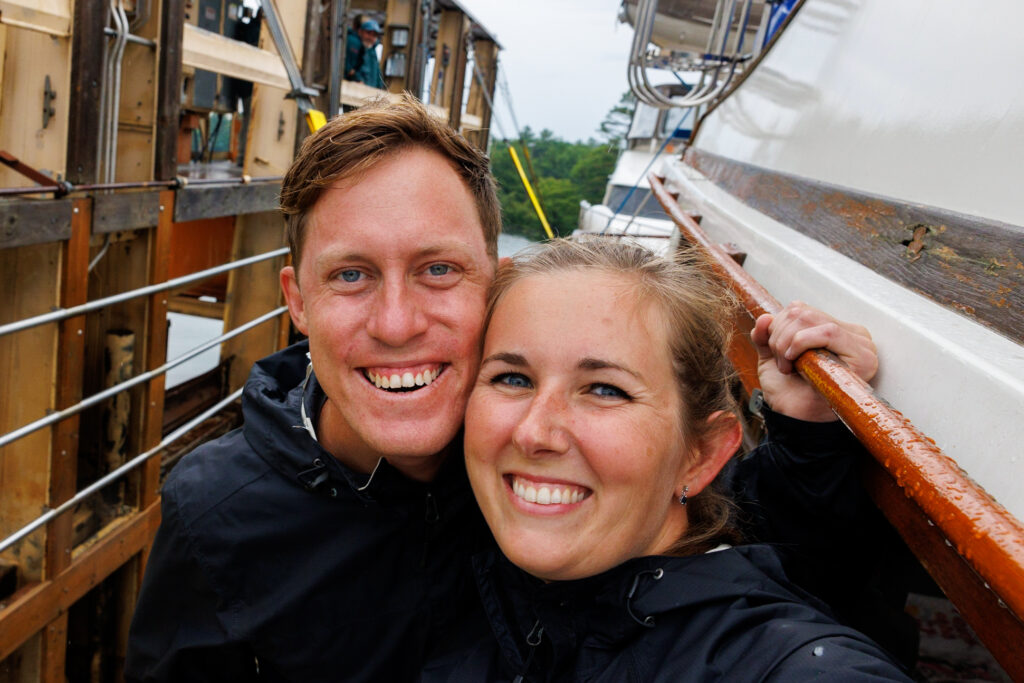

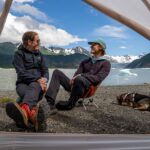
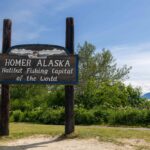

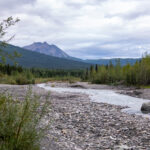

Leave a Reply